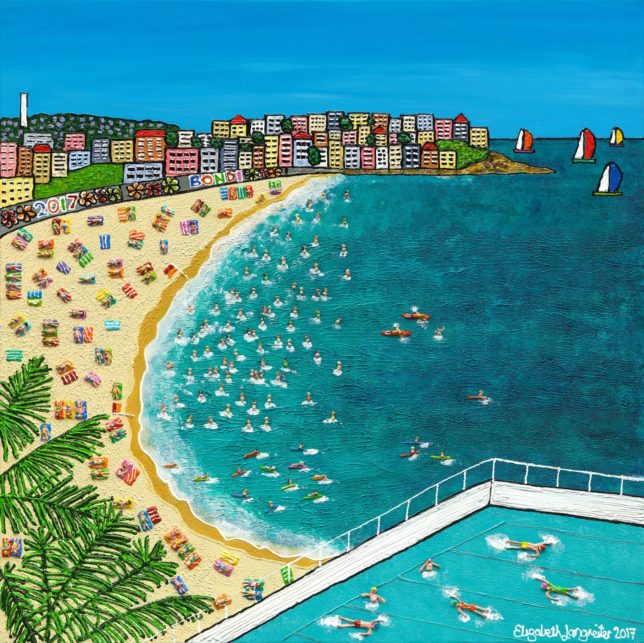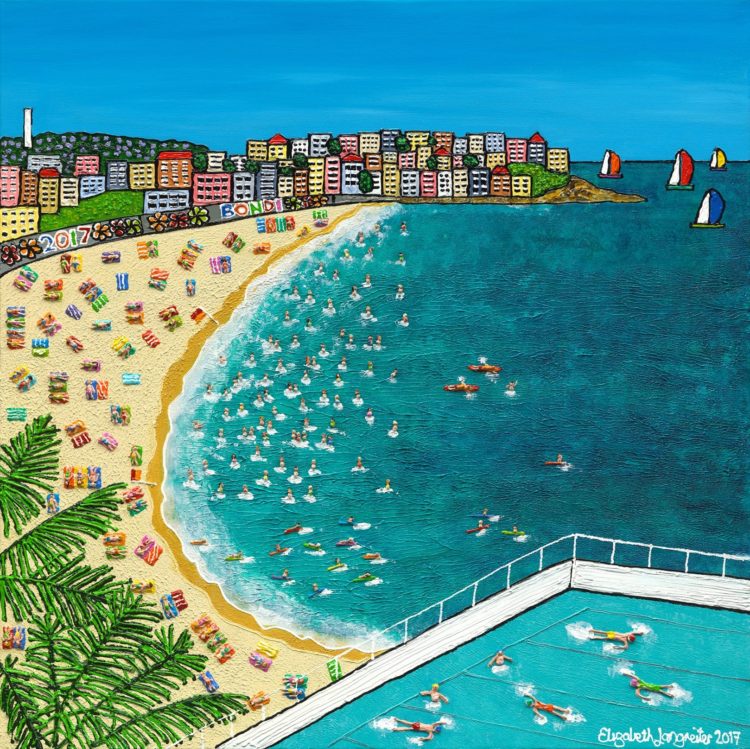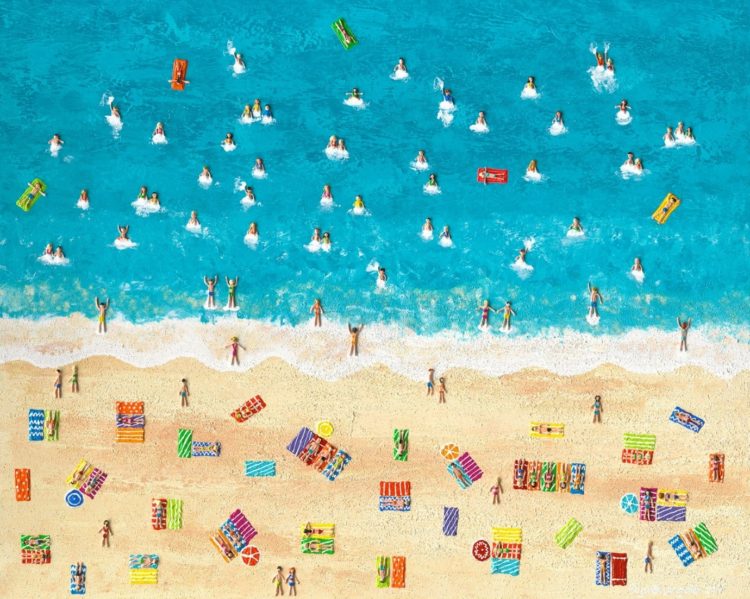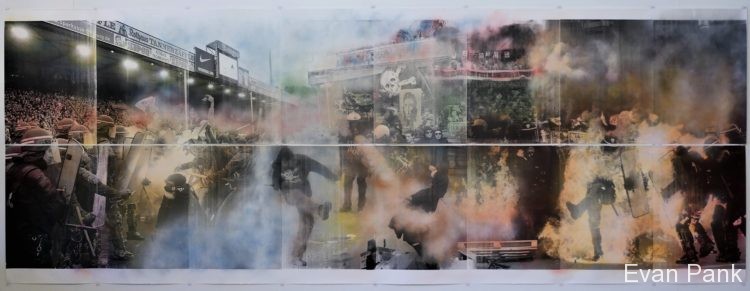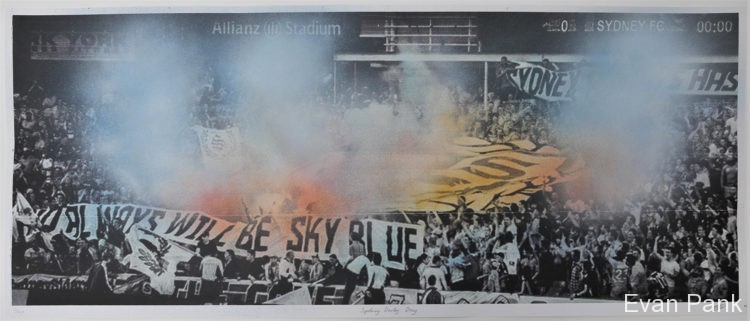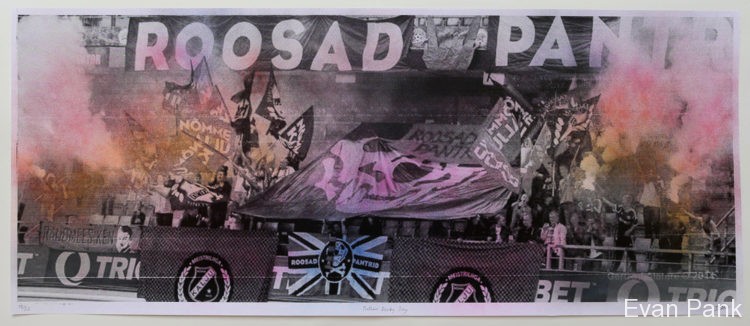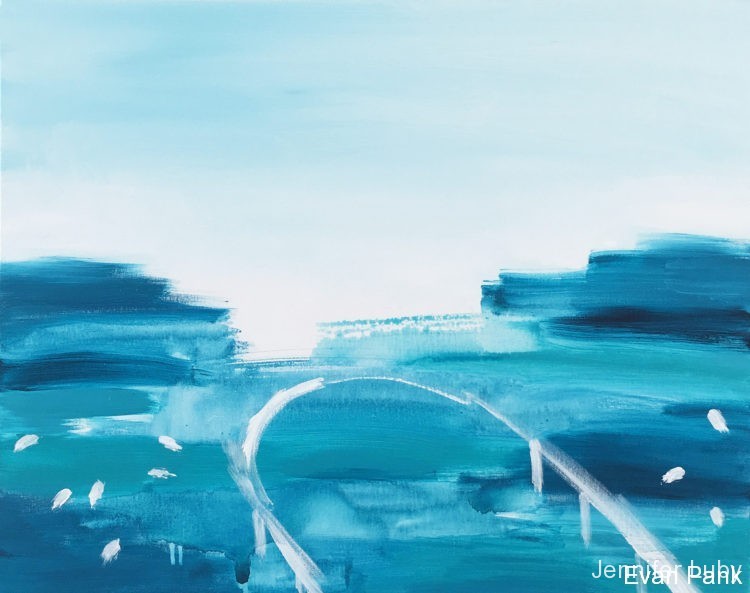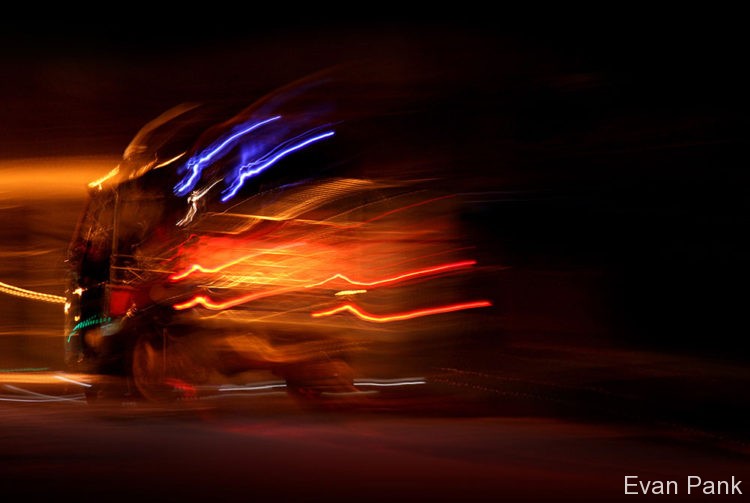The Other Art Fair, for the last two years, has been held in the inner-city, at Redfern’s ATP (Australian Technology Park). At this Fair, you talk to the artists themselves rather than gallery owners. For city makers, it is about urban inspiration and how they chose to depict cities.
City maker Elizabeth Langreiter: eternal, beautiful Sydney
- Why use city imagery?
My husband is Austrian, and we had the opportunity to move there and experience Austrian culture for 18 months in 2013-2014. Our boys also had the chance to go to school and learn to speak German. While I really enjoyed the experience and had my own studio there, I missed my home town of Sydney. I kept seeing all these amazing photos of Vivid Sydney on Facebook from all my friends, which made me very homesick and totally inspired me to paint my own version of Sydney Harbour. This painting was very well received by the Austrians and sold very quickly. That was the first of many paintings inspired by beautiful Sydney.
- How does this fit in with your other themes?
At the time I was painting a lot of colourful abstract art, which I really enjoyed. But I also started to enjoy working in different styles and both my abstract and whimsical styles were becoming popular. I also missed the beach and water and started to paint the water in an abstract and textural style.
- What city subjects do you show?
I now paint beaches and city scapes often from an aerial perspective and with a 3D effect. I sometimes include people. When I do, they are little 3D people built up with many layers. My paintings are always colourful and happy. I want people to smile and feel good and perhaps evoke a happy memory.
- What materials do you use and why?
I use acrylic paints and many different mediums, such as impasto (thick layers of paint), modelling paste, dry mediums, varnish and, in some paintings, resin. Many of my paintings are mixed media on canvas.
- Where is your work exhibited?
I exhibited for the fourth time at The Other Art Fair (2018). To be recognised as one of the top emerging artists in Australia Is a great honour. I also exhibit at The Milk Factory, Bowral and Wentworth Galleries in Sydney CBD. I participate in many other art fairs including The Lindfield Art Show, The Kings Art Fair, The Balmain Arts and Craft Show and St Thomas’ Arts and Craft Show in North Willoughby, and regularly exhibit at Martha’s at Castlecrag and Tallwood at Mollymook. I am also the solo artist at NOC (No Ordinary Café) Willoughby and the Castle Cove Cafe on Deepwater Road Castle Cove.
- Do your future plans include city work?
Yes. I will definitely be painting more city scapes. I never tire of painting my favourite places in Sydney. which include the Harbour and Opera House and beaches, especially Balmoral and Bondi Beach.
- In portraying the city, what was the biggest decision you had to make and why?
My biggest decision is to find a composition and perspective of our city that is interesting and beautiful to me. I look at hundreds of images to get motivated for my next painting.
City maker Clinton Gorst: downtown, high-rises, nature
- Why use city imagery?
Since a child I’ve always loved being in big cities, the huge buildings, the energy of the streets. This transpired into my fascination with architecture, and I draw that content into my work more and more. I lived in London for many years in the 1990s and loved the juxtaposition of that city – the ultra-new clashing with the super traditional. Other cities like New York appeal for cultural references, while in Sydney I’m always marvelled by the amount of natural beauty moments from anywhere – coastal beaches near busy urban areas – it’s heavenly, and unlike most cities on earth for this reason.
- How does this fit in with your other themes?
I’ve been integrating architecture into my collage works for a while now, and the chance to create my own hybrid buildings with collage is a big appeal. I still may tell another story in the final result of the image, and the architecture could be background for this purpose alone.
- What city subjects do you show?
A love of downtown, and highrises/skycrapers, the busy streets that curl around buildings like veins, interesting parks and recreational areas, beaches and blue skies also dominate some of my works. I used to use a lot more people in my art, but that has slowly been retracting, as being more anonymous I think has bigger appeal to viewers – by placing themselves in the surreal context.
- What materials do you use and why?
Paper collage / photomontage, all resourced form a huge library of second hand books and magazines collected over the years. Vintage eras like the 1950s to 1970s particularly thrill, especially the hard brutalism of architecture at the time, and a sense of future utopia. Once all the pieces are hand-scissored, I then glue the collage onto a wood board frame and spray with a protective matt spray. The artworks can then be framed or hung on their own after this process.
- Where is your work exhibited?
In 2017 I participated in group shows in galleries in Berlin and Barcelona after they discovered my Instagram account which was a thrill. I also was part of This Is Sirius exhibition at the National Trust in Sydney to raise awareness of the stunning Sirius building, which sadly is in danger of development and/or destruction. I also showed 18 pieces in Sydney at The Other Art Fair in October which was a great success and an interesting exercise with direct contact with the public.
- Do your future plans include city work?
(When we spoke, he was excited about the Other Art Fair happening again, for which he built a new body of work.)
- In portraying the city, what was the biggest decision you had to make and why?
Finding pieces to fit within the city context is tricky and complex, so each decided piece is extracted from the original resources before adding. The city naturally takes on a montage life of its own.
City maker Evan Pank: streets, rallies, activism
- Why use city imagery?
My work utilises imagery of football stadiums and the streets that are found in cities across Australia and the globe. The inspiration for my work stems from my own passion for football (soccer), supporting Sydney FC across the country for several years and my time in Europe which exposed me to many different supporters, cultures and environments. The football stadium is often regarded as the second home of fans and is one of the most iconic parts of a football club’s identity. It provides a regular meeting point for small communities or whole cities and it is here that people from different backgrounds can come together or be segregated and play out their rivalries with other supporters. The emphatic support from football fans around the globe through songs, flags, flares and tifos (scarves, drapes, flamboyant displays) creates an environment where the stadium becomes a space of boisterous public expression. The strict rules and expected public behaviour can be thrown aside in an emotional outpouring that is exemplified in the stadium but also expands out into the streets of the city and in the pubs. The streets in the city are also a place where fans get to promote their team and build up to the game marching through the streets en masse. The scenes of thousands of people marching together under one banner and chanting, singing in unison also draws parallels to political demonstration.
- How does this fit in with your other themes?
The main themes found in my work are of expressive football fans, commonly utilising flares and smoke. Continuing from this, I also show supporters engaging in political activism in the stadium and using football as a political tool. Expanding further, fan marches and political protest in the streets, where the environment is reclaimed from the usual monotony of day-to-day life and becomes a platform for the people. Finally, I use imagery of clashes with police and particularly riot police. Now, most of this imagery is coming from overseas where shields, helmets and armour aren’t an uncommon sight at rallies; they are also something that seems to be increasing in Australia in our police forces.
The combination of emotional football support and activism found in my work is emphasised through the context of the stadium and street blending together, as shown in my artworks, Keeping the Bastards Honest, 2016 and The Twelfth Man, 2017. Other artworks I have produced focus on the arena of the stadium and examining fan support contained within this structure. Three artworks that show this feature the supporters end of the Sydney Football Stadium with the Sydney FC fans; one end of the A. Le Coq Arena in Tallinn with the supporters group of Nõmme Kalju; and the final one an image of the Ďolíček Stadium in Prague with the supporters of Bohemians 1905, set against the winter night sky and the faint image of apartments behind the ground. Bohemians 1905 was the first European team to tour Australia and they took back two Kangaroos to Prague Zoo. They changed their logo to a kangaroo after the trip and are also known as a traditional football club that is owned by the fans and against the corporatisation of football.
- What city subjects do you show?
While city imagery and particularly stadium imagery is prevalent in my work it is the context that drives my decision for what is included in an artwork. This applies whether I’m creating a work about Australian fan support and activism, the G20 protests in Hamburg, exploring fan support in Estonia or looking at the violent clashes in the streets and stadiums in South America. Places I have visited are a big reference point as well for me, with Australian stadiums being something I can use in my work quite easily along with ones I have visited abroad. Researching images of political activism and clashes at football games, particularly if politically motivated, help to build a library of reference material images to use in my work.
- What materials do you use and why?
My work is made through a combination of screen printing and spray painting. The images used are sourced from my own, friends, photographers and news sources. For my smaller artworks I may use a single image or incorporate two or three. My large-scale works will combine several images together to create a composite, large, mural-like image. This is all done digitally in Photoshop with the final images turned into a half-tone image. The paper I’m working on is spray-painted first, then screen printing the half-tone image over the top. The work is finished by spray painting over the paper again. It takes a bit of trial and error to find the right combination of colour to use and it can be several prints before I come to a final decision on how to use the spray paint.
- Where is your work exhibited?
My work has been In a few exhibitions over the last couple of years including the Fremantle Arts Centre Print Award (Keeping the Bastards Honest was the winning work), The Other Art Fair and SCA (Sydney College of the Arts) Undergraduate Shows 2016 and 2017. This year I’ll be exhibiting at Scratch Art Space at the end of May, Artereal Gallery and as part of an exhibition of emerging artists in the Mildura Print Triennial later in the year. I am still waiting to hear back on more exhibition opportunities.
- Do your future plans include city work?
Future work for the time being will continue with the topics of football support and political activism as well as a crossing over of the two. While I don’t have a specific focus on the city per se, I do see the city as a frame for the actions of the subject matter in the work. It provides an aesthetic quality, symbolism and sometimes an important political or geographical context. As such, the city will certainly feature in my future work though I may look more specifically at how it affects people within the current themes of my artistic practice.
- In portraying the city, what was the biggest decision you had to make and why?
In portraying the city, the biggest consideration was the context and narrative that it provided for the imagery of political demonstration and football supporter culture. As an example of this in my artwork Keeping the Bastards Honest I wanted to explore the intersection of protest and supporter culture with the work being supported by imagery of the fans in the stadium, spilling out onto the streets, blurring the lines between street activism and the role of the stadium in political protest. Expanding on this, The Twelfth Man looks specifically at the role of the stadium as a forum for fan and political expression. Furthermore, this exploration of the stadium is an important part in framing supporter culture in my smaller artworks, where by the stadium represents what can be considered a home to supporters and part of the identity behind fans and a sporting team.
Recently I had an exhibition open at ANCA Gallery in Canberra. As a bit of a change this was a paste-up exhibition on the outside of the gallery and was an interesting expansion of the imagery of my work. Images of political protest and fan culture on the streets now located within the street environment.
https://www.facebook.com/pg/epankart/photos/?tab=album&album_id=1216437285156216
City maker Jennifer Luby: coastline, ocean and pools
- Why use city imagery?
Bondi Icebergs ocean pool is my signature painting and a special place that holds fond memories for me growing up. I spent many an afternoon swimming here with friends and celebrating with family. It’s such an iconic Sydney spot that is instantly recognisable. I reflect its aesthetic with a play on perspective, elongating the pool lanes so you feel as though you could dive into the painting. My colour palette features crisp aqua tones of the ocean pool contrasting with deep turquoise of the ocean lapping next to it and cut through with the sharp white wash that jumps over into the pool.
- How does this fit in with your other themes?
My theme and constant inspiration is the ocean and our coastline, so it fits perfectly.
- What city subjects do you show?
I show the calm and ever-changing landscape of our coastline. I am drawn to the simplicity and tranquility of ocean pools sitting against the sea and find so much inspiration from the contrasts of colours at any time of day and the way you can transport a viewer to a place and time through this visual.
- What materials do you use and why?
I use acrylic paint on canvas. I love the fluidity of acrylic paint and often use a lot of water in my process to bleed out the colours or layers.
- Where is your work exhibited?
I have exhibited in New York and Sydney and have collectors all around the world, including Asia and the United States. I am currently showing my pieces through Art Pharmacy, Zanui, all galleries on Saatchi Art and at Abode, Bondi.
- Do your future plans include city work?
I am looking to expand my series to different beaches and ocean pools around Australia that resonate with people and hopefully I can venture out, capture them and make new memories too.
- In portraying the city, what was the biggest decision you had to make and why?
In portraying Bondi Icebergs, the biggest decision I had to make was what perspective I wanted to paint it from. There are so many angles of the beach, pool and ocean from aerial photography and painting. For me, the view when you look out to the ocean pools with the restaurant and club to the right of you really captures the essence of the spot.
City maker Stephen Kane: light, patterns, neon
- Why use city imagery and what subjects do you show?
Applying to The Other Art Fair Sydney in 2016, I submitted photographs taken on a recent trip to Japan and Thailand. My Shift Series of abstracted neon signs in Shinjuku and rain-soaked streets in Bangkok, were accepted into the exhibition and established my creative practice as an emerging artist. City Imagery is also featured in my most recent “Vivid Series”, captured during Sydney’s spectacular light festival and inspired by the landscapes of light created by illumination and projection technology.
- How does this fit in with your other themes?
These and other series are part of my ongoing project Lightscapes which investigates abstraction through the manipulation of light, utilising in-camera effects and post-photographic digital manipulation to challenge representational and documentarian photography by exploring themes of visual perception, pattern recognition and gestalt theory.
- What materials do you use and why?
Limited edition artwork is printed in vibrant 10 colour pigment ink on metallic archival photographic paper with a glossy 6mm clear acrylic face mount, and frameless hidden hanging system which enables the panel to float from the wall. The finish is smooth and sharp with high optical clarity and visual depth. Light is refracted by the acrylic and reflected by the metallic stock, simulating the visual effects and surface textures of futuristic urban environments.
- Where is your work exhibited?
For the third consecutive year, I was selected to exhibit in The Other Art Fair Sydney in Mar 2018. I previously showed at The Other Art Fair Sydney in Oct 2017. My first solo exhibition opened at Gaffa Gallery in Sydney during July 2017. I exhibited in Singapore Contemporary Art Fair in Jan 2017 and my first show was The Other Art Fair Sydney in Oct 2016.
- Do your future plans include city work?
I hope to include further metropolitan travel, specifically to the high-tech cities of the future.
- In portraying the city, what was the biggest decision you had to make and why?
Selecting some and eliminating other artwork to shape cohesive stories did prove to be challenging initially. However, the various images and series eventually coalesced into the macro scale theme of Lightscapes.

